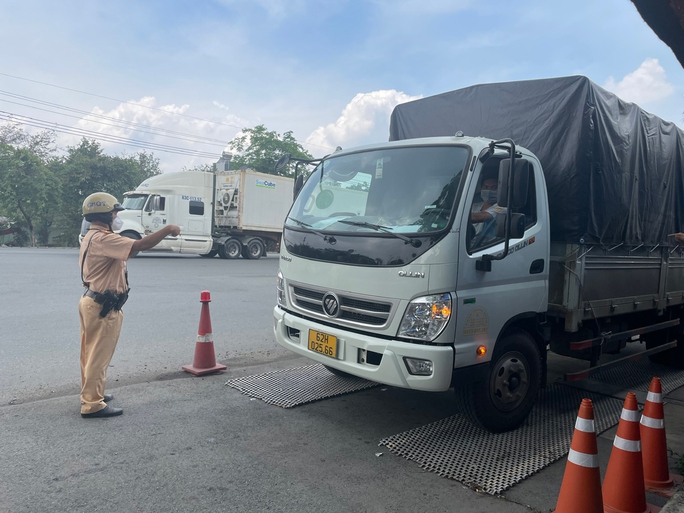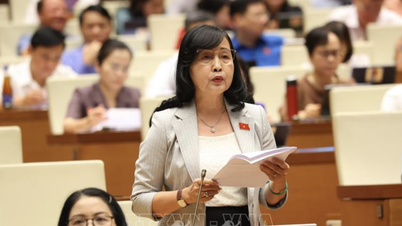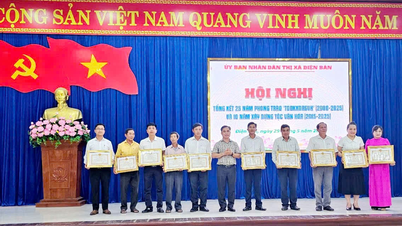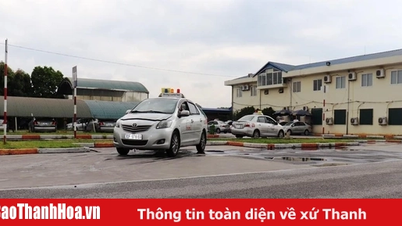Last week, at the weighing station on Nguyen Van Linh Street from District 7 to Binh Chanh District, Ho Chi Minh City, reporters recorded a dense flow of vehicles.
Inconvenient 2-level scale
During the 11am - 2pm time frame, many cars drove slowly, even causing congestion at the Nguyen Van Linh - Pham Hung intersection extending to Ong Lon bridge.
When an overloaded vehicle passes, the alarm bell rings, the traffic inspectors will signal the driver to stop based on the license plate number transmitted to the control center and ask the driver to move to the secondary scale to confirm the result. If the overload is re-confirmed, the traffic inspector will draw up a record of the administrative violation.
"Although the process is simple, it must be applied flexibly because in reality, the alarm bell rings while the vehicles are lined up closely together, causing the weight data to be inaccurate," said a traffic inspector on duty here.

Authorities check vehicle load at weighing station number 3
Not only the Department of Transport Inspectorate, the fines for overloaded vehicles will be coordinated by the Traffic Police and related forces to increase efficiency. After a year of piloting, the Department of Transport will summarize and evaluate the implementation results, and report to the Ho Chi Minh City People's Committee on the expansion plan.
Similarly, at the weighing station at the An Suong - An Lac toll station (National Highway 1, Binh Tan District, Ho Chi Minh City), although the scale operates 24/7, the traffic inspection force only stops vehicles for processing from 10 p.m. to 1 a.m. the following day. Explaining, Mr. Phan Minh Hai - Deputy Head of Traffic Inspection Team No. 8, in charge of handling violations at weighing stations No. 6 and No. 7 (An Suong - An Lac toll station area) - said that National Highway 1 from District 12 to Binh Tan District has a very high traffic volume, and conducting inspections during the day can easily lead to the risk of congestion on National Highway 1.
To overcome the shortcomings on the roads, Ho Chi Minh City has just allowed a pilot program to fine overloaded vehicles. The pilot program is applied at 3 vehicle weight inspection stations including station 3 (Ong Lon bridge area, from Binh Chanh district to district 7), stations 6 and 7.
Increase transparency, reduce opposition
A representative of the Ho Chi Minh City Department of Transport said that implementing fines for overloaded vehicles helps ensure security and order, and limit cases of opposition and disorder at weigh stations. In addition, it limits the impact of inspection forces, increases transparency, etc.
Accordingly, the automatic weighing system has sensors placed under the road, has a camera that automatically captures license plates, reads out information such as the vehicle owner's name, vehicle weight, permitted cargo weight, container size... The system will automatically calculate whether the vehicle violates the load limit and to what extent.
According to the procedure, every day, the staff of the Ho Chi Minh City Urban Traffic Management Center will access the vehicle load control system to search for and extract weighing tickets for vehicles exceeding the load and violation level, and transfer the file to request a penalty to the Department of Transport Inspectorate.
Upon receiving the application, the Department of Transport Inspectorate verifies the information, prepares a processing file and sends a notice to the vehicle owner. If the vehicle owner has not arrived within the processing time limit, the processing unit sends a notice to the vehicle inspection agency to place the vehicle on a warning list related to administrative violations.
Mr. Le Van Thuong, Deputy Chief Inspector of the Department of Transport, said that currently, the work of penalizing overloaded vehicles in Ho Chi Minh City is facing some difficulties. Specifically, the inspection force and checkpoints at the weighing stations are too thin, while 7 weighing stations are spread out at the gateways, operating 24/24, 7 days a week. In addition, the inspection force does not have the authority to chase when the violating vehicles run away, some vehicle owners often argue, cause trouble, and do not comply with the handling of violations...
The cold fine will not need to apply 2 scales. The high-precision sensor weighing system will help clearly identify overloaded vehicles, thereby increasing processing efficiency.
"With a strict process, handling overloaded vehicles will be easier. During the process, if people do not agree with the results, they can file a complaint according to the law. Currently, the Department of Transport Inspectorate is developing a plan to implement fines to submit to the Department of Transport for approval and implementation in the near future," Mr. Le Van Thuong informed.
Should be done soon
Regarding the application of fines for overloaded vehicles, Mr. Bui Van Quan, Chairman of the Ho Chi Minh City Freight Transport Association, commented that it is very necessary and should be implemented soon.
According to Mr. Quan, after the COVID-19 pandemic, many transportation businesses fell into difficulty due to lack of orders. In addition, the "struggling" at inspection centers further exhausted businesses.
"One of the current injustices is that vehicles carrying the right load cannot compete on price with overloaded vehicles. This not only creates an unhealthy competitive environment but also causes negative consequences for society when many vehicle owners have to do whatever it takes to make a living. Therefore, the fines need to be applied early to improve the handling efficiency, not only at the three weighing stations mentioned above, but the city needs to soon expand to weighing stations located at the city's gateways," Mr. Quan proposed.
As the owner of a freight transport business from Ho Chi Minh City to the Western provinces, Mr. Tran Quoc Hung (District 6) agrees with the fines. Mr. Hung also believes that some business owners have found ways to bypass the weight inspection stations. Because they carry a lot of goods and avoid fines, they offer low prices, which inadvertently "crush" healthy businesses. "This reality is very difficult to say. Therefore, if fines are imposed, they will be clear in black and white, and no one can hesitate to guess this or that," said Mr. Hung.
On the local side, Ms. Tran Thi Tan, who lives in District 12, said that every day she travels from Tan Thoi Hiep Bridge to her workplace near Ga Intersection, which is only a few kilometers, but she is very stressed because every now and then a unit sets up barriers to repair the road, causing congestion. After the road is repaired, it is bumpy and uneven. Ms. Tan asserted that this inconvenience and danger is contributed by vehicles that disregard weight regulations. If fines are imposed, done correctly, and strictly punished, the government will have less money to spend on repairs and people will be safer.
Thousands of vehicles violated
Through the system of weighing stations to check the load in Ho Chi Minh City, in the period of 2016-2021, the Department of Transport Inspectorate inspected 7,544 vehicles. Thereby, it detected and recorded 6,166 cases of 3,150 vehicles violating the permitted load with a fine of nearly 80 billion VND.
In 2021, the HCM City Department of Transport Inspectorate inspected 2,963 vehicles and recorded 1,106 violations with a fine of more than 17 billion VND.
From January 1, 2023 to present, authorities have recorded more than 200 violations, with fines totaling over 10 billion VND.
Source































































































Comment (0)